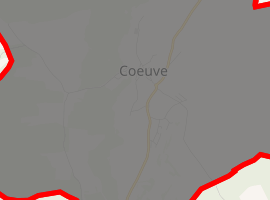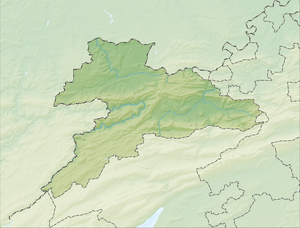Coeuve
Coeuve is a municipality in the district of Porrentruy in the canton of Jura in Switzerland.
Coeuve | |
|---|---|
 Coat of arms | |
Location of Coeuve 
| |
 Coeuve  Coeuve | |
| Coordinates: 47°27′N 07°06′E | |
| Country | Switzerland |
| Canton | Jura |
| District | Porrentruy |
| Government | |
| • Mayor | Maire |
| Area | |
| • Total | 1.59 km2 (0.61 sq mi) |
| Elevation | 432 m (1,417 ft) |
| Population (2018-12-31)[2] | |
| • Total | 734 |
| • Density | 460/km2 (1,200/sq mi) |
| Postal code | 2932 |
| SFOS number | 6781 |
| Surrounded by | Porrentruy, Courchavon, Courtemaîche, Damphreux, Vendlincourt, Alle |
| Website | www SFSO statistics |
History
Coeuve is first mentioned in 1136 as Cova.[3]
Geography
Coeuve has an area of 11.62 km2 (4.49 sq mi).[4] Of this area, 6.61 km2 (2.55 sq mi) or 56.8% is used for agricultural purposes, while 4.36 km2 (1.68 sq mi) or 37.5% is forested. Of the rest of the land, 0.58 km2 (0.22 sq mi) or 5.0% is settled (buildings or roads), 0.02 km2 (4.9 acres) or 0.2% is either rivers or lakes and 0.01 km2 (2.5 acres) or 0.1% is unproductive land.[5]
Of the built up area, housing and buildings made up 3.0% and transportation infrastructure made up 1.5%. Out of the forested land, all of the forested land area is covered with heavy forests. Of the agricultural land, 37.9% is used for growing crops and 15.6% is pastures, while 3.3% is used for orchards or vine crops. All the water in the municipality is flowing water.[5]
The municipality is located in the Porrentruy district.
Coat of arms
The blazon of the municipal coat of arms is Azure, a Bend sinister Or, in chief dexter a Fleur-de-lis of the same.[6]
Demographics
Coeuve has a population (as of December 2018) of 734.[7] As of 2008, 6.6% of the population are resident foreign nationals.[8] Over the last 10 years (2000–2010) the population has changed at a rate of 3.3%. Migration accounted for 3.9%, while births and deaths accounted for 2.3%.[9]
Most of the population (as of 2000) speaks French (607 or 95.3%) as their first language, German is the second most common (18 or 2.8%) and Portuguese is the third (5 or 0.8%). and 1 person who speaks Romansh.[10]
As of 2008, the population was 47.7% male and 52.3% female. The population was made up of 305 Swiss men (44.7% of the population) and 21 (3.1%) non-Swiss men. There were 336 Swiss women (49.2%) and 21 (3.1%) non-Swiss women.[11] Of the population in the municipality, 350 or about 54.9% were born in Coeuve and lived there in 2000. There were 171 or 26.8% who were born in the same canton, while 53 or 8.3% were born somewhere else in Switzerland, and 43 or 6.8% were born outside of Switzerland.[10]
As of 2000, children and teenagers (0–19 years old) make up 28.6% of the population, while adults (20–64 years old) make up 52.9% and seniors (over 64 years old) make up 18.5%.[9]
As of 2000, there were 263 people who were single and never married in the municipality. There were 326 married individuals, 40 widows or widowers and 8 individuals who are divorced.[10]
As of 2000, there were 233 private households in the municipality, and an average of 2.7 persons per household.[9] There were 54 households that consist of only one person and 26 households with five or more people. In 2000, a total of 229 apartments (88.1% of the total) were permanently occupied, while 18 apartments (6.9%) were seasonally occupied and 13 apartments (5.0%) were empty.[12] The vacancy rate for the municipality, in 2010, was 0.34%.[9]
The historical population is given in the following chart:[3][13]

Sights
The entire village of Coeuve is designated as part of the Inventory of Swiss Heritage Sites[14]
Politics
In the 2007 federal election the most popular party was the CVP which received 31.67% of the vote. The next three most popular parties were the FDP (23.21%), the SPS (22.56%) and the SVP (12.36%). In the federal election, a total of 236 votes were cast, and the voter turnout was 46.1%.[15]
Economy
As of 2010, Coeuve had an unemployment rate of 3.8%. As of 2008, there were 54 people employed in the primary economic sector and about 16 businesses involved in this sector. 56 people were employed in the secondary sector and there were 9 businesses in this sector. 49 people were employed in the tertiary sector, with 12 businesses in this sector.[9] There were 284 residents of the municipality who were employed in some capacity, of which females made up 38.4% of the workforce.
In 2008 the total number of full-time equivalent jobs was 124. The number of jobs in the primary sector was 33, all of which were in agriculture. The number of jobs in the secondary sector was 53 of which 39 or (73.6%) were in manufacturing and 15 (28.3%) were in construction. The number of jobs in the tertiary sector was 38. In the tertiary sector; 8 or 21.1% were in wholesale or retail sales or the repair of motor vehicles, 9 or 23.7% were in the movement and storage of goods, 6 or 15.8% were in a hotel or restaurant, 3 or 7.9% were technical professionals or scientists, 5 or 13.2% were in education.[16]
In 2000, there were 91 workers who commuted into the municipality and 183 workers who commuted away. The municipality is a net exporter of workers, with about 2.0 workers leaving the municipality for every one entering. About 28.6% of the workforce coming into Coeuve are coming from outside Switzerland.[17] Of the working population, 6% used public transportation to get to work, and 66.2% used a private car.[9]
Religion
From the 2000 census, 528 or 82.9% were Roman Catholic, while 29 or 4.6% belonged to the Swiss Reformed Church. Of the rest of the population, there was 1 member of an Orthodox church, and there were 6 individuals (or about 0.94% of the population) who belonged to another Christian church. There were 2 (or about 0.31% of the population) who were Islamic. There was 1 person who was Buddhist. 49 (or about 7.69% of the population) belonged to no church, are agnostic or atheist, and 24 individuals (or about 3.77% of the population) did not answer the question.[10]
Education
In Coeuve about 173 or (27.2%) of the population have completed non-mandatory upper secondary education, and 33 or (5.2%) have completed additional higher education (either university or a Fachhochschule). Of the 33 who completed tertiary schooling, 78.8% were Swiss men, 18.2% were Swiss women.[10]
The Canton of Jura school system provides two year of non-obligatory Kindergarten, followed by six years of Primary school. This is followed by three years of obligatory lower Secondary school where the students are separated according to ability and aptitude. Following the lower Secondary students may attend a three or four year optional upper Secondary school followed by some form of Tertiary school or they may enter an apprenticeship.[18]
During the 2009-10 school year, there were a total of 42 students attending 3 classes in Coeuve. There were no kindergarten classes in the municipality.[19] The municipality had 3 primary classes and 42 students.[20] There are only nine Secondary schools in the canton, so all the students from Coeuve attend their secondary school in another municipality.
As of 2000, there were 42 students from Coeuve who attended schools outside the municipality.[17]
References
- "Arealstatistik Standard - Gemeinden nach 4 Hauptbereichen". Federal Statistical Office. Retrieved 13 January 2019.
- "Ständige Wohnbevölkerung nach Staatsangehörigkeitskategorie Geschlecht und Gemeinde; Provisorische Jahresergebnisse; 2018". Federal Statistical Office. 9 April 2019. Retrieved 11 April 2019.
- Coeuve in German, French and Italian in the online Historical Dictionary of Switzerland.
- Arealstatistik Standard - Gemeindedaten nach 4 Hauptbereichen
- Swiss Federal Statistical Office-Land Use Statistics 2009 data (in German) accessed 25 March 2010
- Flags of the World.com Archived September 7, 2015, at the Wayback Machine accessed 29-December-2011
- Swiss Federal Statistical Office - STAT-TAB, online database – Ständige und nichtständige Wohnbevölkerung nach institutionellen Gliederungen, Geburtsort und Staatsangehörigkeit (in German) accessed 23 September 2019
- Swiss Federal Statistical Office - Superweb database - Gemeinde Statistics 1981-2008 Archived June 28, 2010, at the Wayback Machine (in German) accessed 19 June 2010
- Swiss Federal Statistical Office Archived January 5, 2016, at the Wayback Machine accessed 29-December-2011
- STAT-TAB Datenwürfel für Thema 40.3 - 2000 Archived April 9, 2014, at the Wayback Machine (in German) accessed 2 February 2011
- Canton Jura Statistics- Population résidante permanente au 1er janvier 2010, canton du Jura et communes Archived April 26, 2012, at the Wayback Machine (in French) accessed 2 March 2011
- Swiss Federal Statistical Office STAT-TAB - Datenwürfel für Thema 09.2 - Gebäude und Wohnungen Archived September 7, 2014, at the Wayback Machine (in German) accessed 28 January 2011
- Swiss Federal Statistical Office STAT-TAB Bevölkerungsentwicklung nach Region, 1850-2000 Archived September 30, 2014, at the Wayback Machine (in German) accessed 29 January 2011
- "Kantonsliste A-Objekte". KGS Inventar (in German). Federal Office of Civil Protection. 2009. Archived from the original on 28 June 2010. Retrieved 25 April 2011.
- Swiss Federal Statistical Office, Nationalratswahlen 2007: Stärke der Parteien und Wahlbeteiligung, nach Gemeinden/Bezirk/Canton Archived May 14, 2015, at the Wayback Machine (in German) accessed 28 May 2010
- Swiss Federal Statistical Office STAT-TAB Betriebszählung: Arbeitsstätten nach Gemeinde und NOGA 2008 (Abschnitte), Sektoren 1-3 Archived December 25, 2014, at the Wayback Machine (in German) accessed 28 January 2011
- Swiss Federal Statistical Office - Statweb (in German) accessed 24 June 2010
- EDK/CDIP/IDES (2010). Kantonale Schulstrukturen in der Schweiz und im Fürstentum Liechtenstein / Structures Scolaires Cantonales en Suisse et Dans la Principauté du Liechtenstein (PDF) (Report). Retrieved 24 June 2010.
- Effectifs de l'école enfantine 2009-2010 Archived April 14, 2012, at the Wayback Machine (in French) accessed 19 December 2011
- Effectifs de l'école primaire (in French) accessed 19 December 2011
External links
| Wikimedia Commons has media related to Coeuve. |
- Coeuve in German, French and Italian in the online Historical Dictionary of Switzerland.